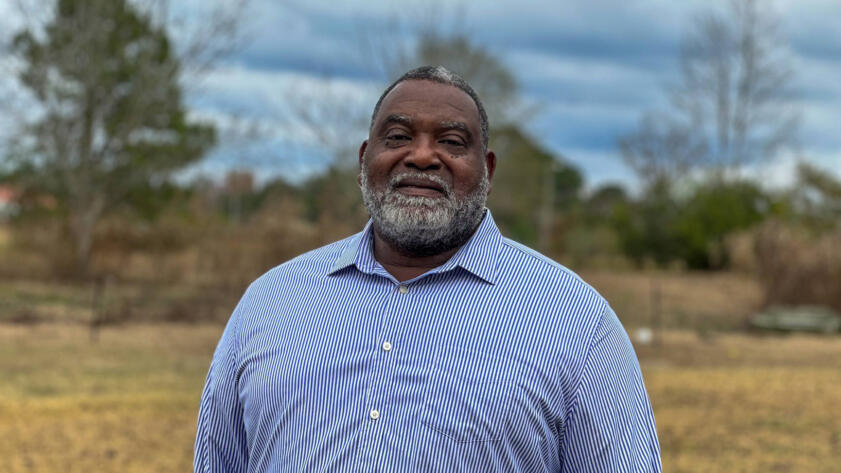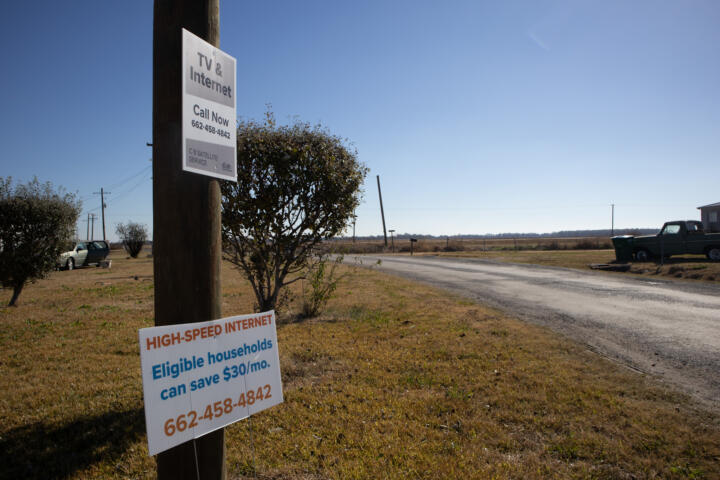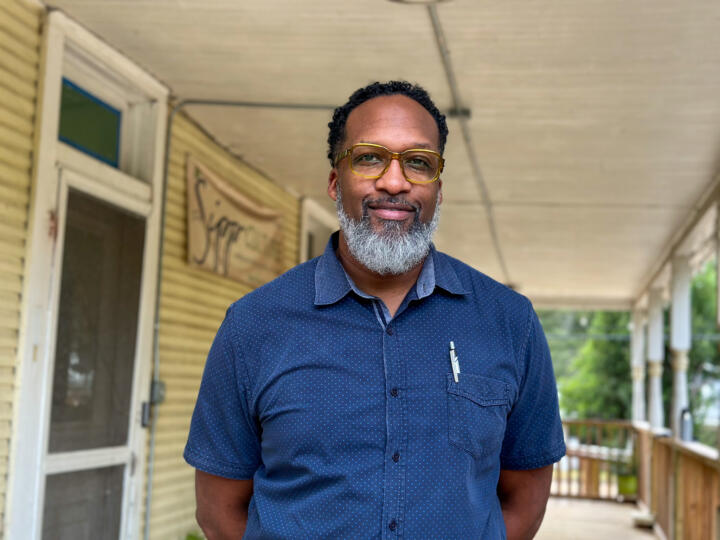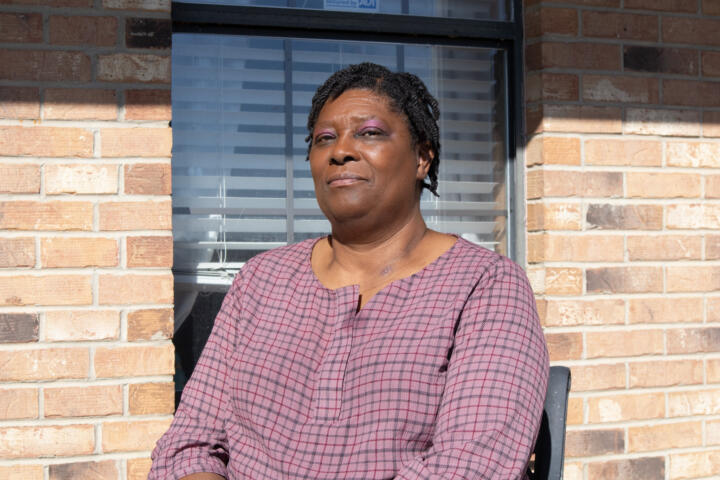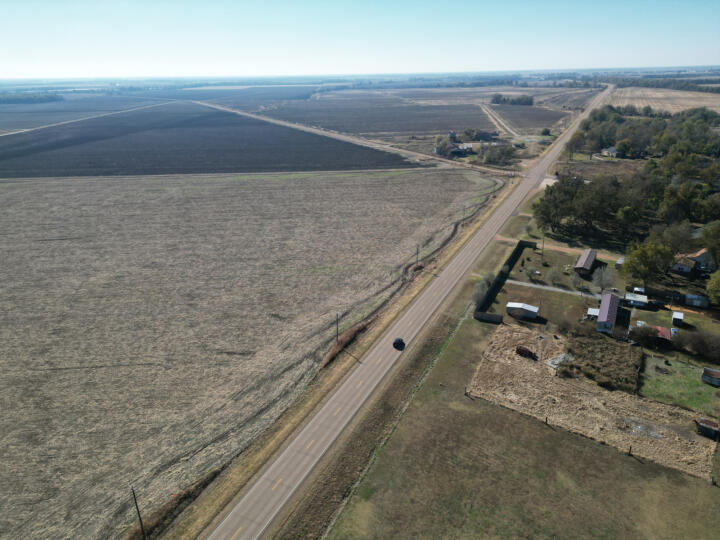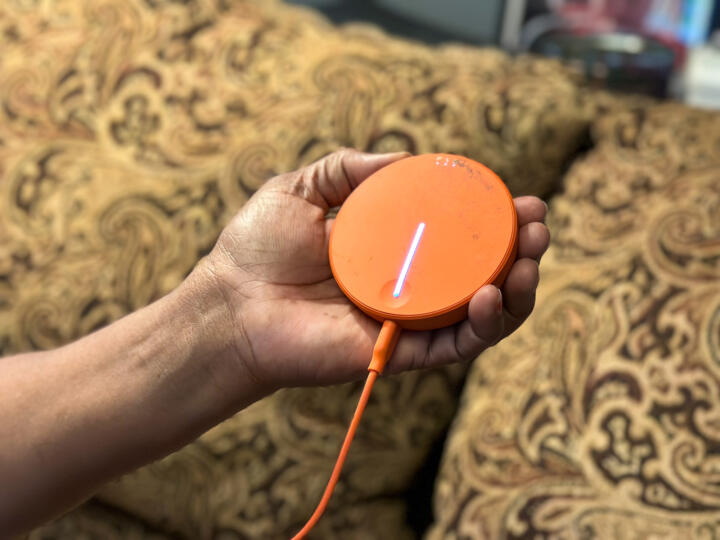This story was published in partnership with Capital B, a local-national nonprofit news organization that centers Black voices, audience needs and experiences, and partners with the communities it serves. Subscribe to its newsletters here.
This is the first story in Capital B’s “Disconnected: Rural Black America and the Digital Divide” project, which explores the disparate effects of broadband accessibility on Black Americans in the rural South. This project is made possible by a grant from The Center for Rural Strategies and Grist.
Military veteran Obbie Riley is “sad, angry, and all of the above” as he thinks about the high cost and lack of broadband access in his rural Mississippi hometown.
He became a Neshoba County supervisor in 2008 in the small town of Philadelphia after serving in the U.S. Coast Guard for 22 years. His first order of business was to ensure all homes had access to high-speed internet, which the late U.S. Rep. John Lewis called “the civil rights issue of the 21st century.” Riley recalls how he could barely get a steady signal on his cellphone, let alone high-speed broadband—or home internet service. He settled on a service that was the only available option, and it became expensive and slow—costing him up to $150 a month. It also restricted his ability to search the internet for information or order parts for his job as a mechanic.
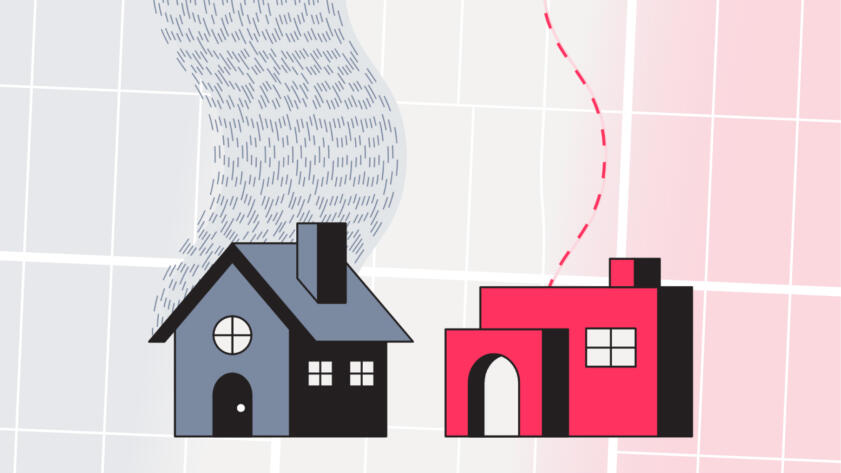
Still Loading
Dollars to Megabits, You May Be Paying 400 Times As Much As Your Neighbor for Internet Service
An investigation by The Markup found that AT&T, Verizon, EarthLink, and CenturyLink disproportionately offered lower-income and least-White neighborhoods slow internet service for the same price as speedy connections they offered in other parts of town
For others, he learned, it blocked their chances to work remotely, find higher paying jobs, submit school work, and access educational or telehealth services—in a town that has only one hospital, which recently closed one of its two nurse stations due to staff shortages. It became difficult for some residents to pay a bill online, complete school work, and access unemployment benefits or banking services.
After more than 15 years of his pursuit, not much has changed. Today, about 21% of households in Philadelphia don’t have internet subscriptions. Back in 2008, he thought, “If in the ’30s and ’40s we put electricity to every house in rural America, how difficult could it be to put internet to every house?”
He quickly learned it would cost around $23 million to build fiber optic cable to every household. For years, he’s been repeatedly told by state and county officials that no money was available to build out infrastructure. He partially blames leaders’ lack of willingness to do it, he said.
Beyond costs, some White leaders have simply told Riley their constituents “like it just like it is.”
“To me, that’s just like a car driving past the road, and your neighbor says, ‘Well, I got a set of mules back there that I hook up and I ride him to town, and it only takes me a day to get up there,’” Riley said. “It’s the most ridiculous thing.”
For decades, millions of Americans have been forced to go without internet or pay for subpar service, which thwarts opportunities to participate and thrive in today’s society, especially for Black communities in the rural South, where the digital divide is the greatest. In this region, about 38% of Black households don’t have home internet, a higher percentage than White people in the same region and the national average, a 2021 report from the Joint Center for Political and Economic Studies found.
Given the history of neglect to Black communities, residents in rural Alabama, Georgia, and Mississippi told Capital B they question whether the billions of dollars from the feds for broadband will reach their area.
Philadelphia, Miss., is 54% Black, and the median income is $37,000. A Brookings Institution study showed that the less money an individual makes, the more likely they won’t have access to high-speed broadband. Black and Hispanic populations are disproportionately affected.
As a result, Black people, young adults, and low-income folks rely on smartphones for internet access, according to Pew Research Center. In a tech-driven society, there are “workarounds” for this, such as driving to the nearest library (if there is one, or you have a car) or using a neighbor’s computer, Riley said, but it requires additional time and money.
In a region that already lacks access to good paying jobs, healthy food, public transportation, and health care, this essential “utility” is critical, Riley said, adding it could help lift some folks out of poverty by reducing “the deep racial and economic inequalities in education, jobs, and health care.” At the very least, Riley hopes it could bring his rural community into the 21st century.
As society moves online, many are left behind
The issue is complicated. Yet it boils down to years of limited federal funding, labor and supply chain shortages, lack of infrastructure investment, and inaccurate data on broadband availability. What makes it even worse is digital redlining, which systematically excludes low-income and Black neighborhoods from the service. When the COVID-19 pandemic amplified the disparities, President Joe Biden signed into law the Infrastructure Investment and Jobs Act, which authorized $65 billion for broadband. Of that, $42.5 billion goes to states through the Broadband Equity, Access, and Deployment (BEAD) program. Currently, each state is planning how to disperse the funds, but the rollout will happen over the next four years or so.
As Nicol Turner Lee, senior fellow of governance studies and director of the Center for Technology Innovation at the Brookings Institution, wrote in 2022, funding, broadband availability, affordability, and digital literacy are not enough to solve the digital divide. Efforts must address poverty, geographic and social isolation, and digital equity, which is a requirement with BEAD.
Without a target strategy, researchers predict the rural South will have fewer jobs by the next decade, and a majority of Black and Latino people could be locked out because of the digital divide. Experts worry Black workers won’t have the digital skills necessary to survive. In her research, Turner Lee found Black people in the rural South who wanted to do remote work but couldn’t due to access, so they went to a local hotel to use the computer.
“What we’re finding is as society moves online, it has to be ubiquitously available for people to benefit from it,” Turner Lee told Capital B. “The question is whether or not those state legislators are going to allocate those funds towards these communities, and they tend to be the last on the list when it comes to giving real funds to make systemic change.”
Disparities in technology and internet access have always been prevalent.
In the late ’90s, the Department of Commerce’s National Telecommunications and Information Administration (NTIA) conducted a study that found disparities across race, education, income, age, and geography within computer, internet, and phone access between 1994 and 1997. Despite growth in computer ownership and online access, Black and Hispanic populations lagged further behind than White people—even across income levels. In rural areas, access remained the lowest.
“There are still pockets of ‘have nots’ among the low-income, minorities, and the young, particularly in rural areas and central cities,” the study found. “These populations are among those, for example, that could most use electronic services to find jobs, housing, or other services.”
Today, the same marginalized communities are the hardest hit by the divide. Some reasons include the lack of federal funding and underinvestment from internet service providers, which have resulted in slower speeds or limited provider options in rural areas, especially Black neighborhoods. Internet providers say it’s not economically feasible to build in rural areas due to geography and topography.
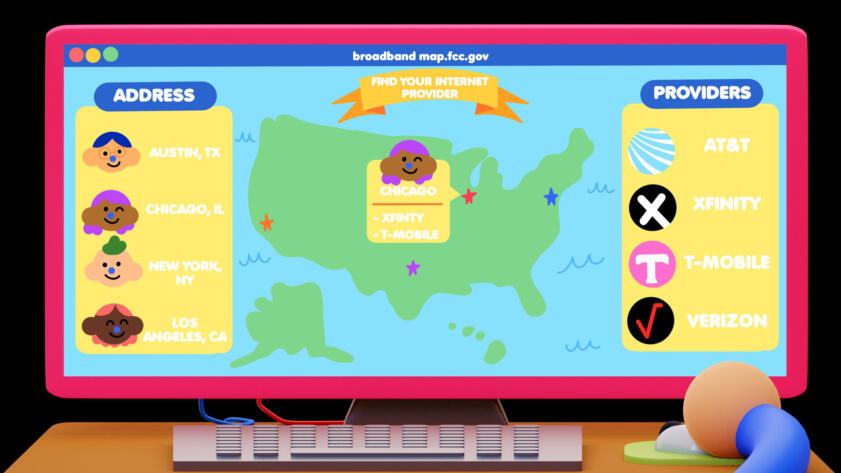
The BreakdownStill Loading
How to Search for a Better Deal on Broadband
You might even be able to help improve crucial government broadband data in the process
Experts point to racism in the housing industry as the basis for the digital divide, especially since majority-Black counties tend to have less access to broadband. Dominique Harrison, tech policy expert and former director of the technology program at the Joint Center for Political and Economic Studies, said this is directly connected to where broadband providers choose to build out their infrastructure.
An investigation by The Markup found that in 38 major cities, four internet providers, including AT&T, offered the worst internet deals in neighborhoods that were lower-income, historically redlined, or had the fewest White residents compared to other parts of the same city.
“There is a connection with where people live, and the services that they receive, and that’s something that should definitely be investigated in terms of state and local leaders to get an understanding of where these internet service providers are falling short,” Harrison told Capital B.
As Turner Lee emphasized: “Why we see the digital divide persist is because history has shown us over the years where we make investments and where we do not.”
Why equitable access to high-speed internet is critical
In Utica, Miss., a mere 35 miles from the state capital of Jackson, Carlton Turner reminisces on how his once-thriving town isn’t even an afterthought for development. When the high school closed in the mid-’90s, local businesses and the only grocery store followed suit, leaving many to move elsewhere. Ever since, no one has tried to invest in the 75% Black town of more than 780 people.
Now, he’s trying to change that trajectory through his organization, the Mississippi Center for Cultural Production, or “Sipp Culture,” which supports community development through arts, storytelling, and economic development.
But, having equitable access to high-speed internet is critical to the work. At the Sipp Culture headquarters in Utica, the spotty “AOL-like” service makes it hard to host Zoom calls, edit photos in Adobe Lightroom, and download videos from Adobe Premiere—the software needed to create digital storytelling. Hinds County, where Utica is located, has the third-highest rate of unserved locations when it comes to broadband.
“We don’t have the speed to be able to get online and process or render a video or transmit a high quality video across the internet. It takes us much longer to do basic tasks,” Turner said. “That has fundamentally changed the way that we have to operate, which means it costs more money for us to do business across the board. That’s a challenge for anybody who is looking at investing in the future of the community.”
Turner is frustrated as he thinks about his attempts to get better quality service, particularly at his home. Last year, he found out his White neighbor had AT&T. Turner had called AT&T previously, but says he was told they didn’t service his area.
He went back home and saw the fiber optic line, which goes across his property and under the road. He called the company again, he says. He heard a familiar answer: They don’t service his area. He asked to speak with a supervisor.
“I put them on FaceTime, and I just traced the line … and then turn to show them that’s my house right there, and you’re telling me that I can’t get it, but it’s coming from my yard,” Turner said. “There’s something systemic in that that needs to be checked out.”
Days later, Turner says he was able to subscribe to AT&T’s service.
In an email response, an AT&T spokesperson said the company is committed to providing high-speed, reliable connectivity to Americans across the country, and that it was difficult to comment on the allegations without the customer’s address. (Capital B did not provide AT&T with Turner’s address.)
“We consider a variety of economic factors and cost evaluations when deciding where to build networks. Race is not among those,” the statement said. “We continue to aggressively expand our fiber footprint and actively participate in federal broadband funding programs to help bring the benefits of connectivity to all Americans, including those who live in more sparsely populated areas.”
The company advises customers to look up service availability on att.com, or call (800) 288-2020 to check availability at their address.
On Main Street, the center of downtown, C Spire, an internet service provider, deployed fiber optic cables. Sipp Culture’s building is only a few miles away—however, Turner is unable to access the service.
“If you’re within a town center, every street you have should have access, not just the main street. That’s not where the bulk of the people live; they live in neighborhoods,” he added. “[Companies] are meeting benchmarks that are arbitrary, or set by people that have no connection to the community design or development or the way that that community wants to develop.”
Living in isolation with limited options
Evelyn Washington sees the disinvestment every day in her hometown of Rome, Miss., an unincorporated, mostly retired community of about 200 people. There’s no grocer, nor restaurants, convenience stores, health clinic, or a fire hydrant—only a post office. Residents travel more than 20 miles for all their needs.
In times of emergencies, residents wait lengthy times for police officers, firefighters, or EMT staff to arrive because the community is so small and isolated. In some areas, it is hard to find while using GPS. She recalled a recent tornado that devastated the community a few years ago. Since there isn’t a tornado siren, a friend in a neighboring community called her to tell her to take cover.
It’s difficult to keep this Mississippi Delta community informed when the internet is out of their reach. Most people rely on their phones or television—if they have cable. There’s also an online grocery service that delivers to Rome, but without the internet, residents can’t place an order.
For years, Washington tried to get AT&T home internet service, but they told her “they don’t service my area.” She tried Viasat, another internet provider. She purchased a satellite dish, but the service was too slow. Then, she learned about HughesNet, which advertised high-speed satellite internet, she said. The service was spotty and she couldn’t complete her school assignments or watch TV.
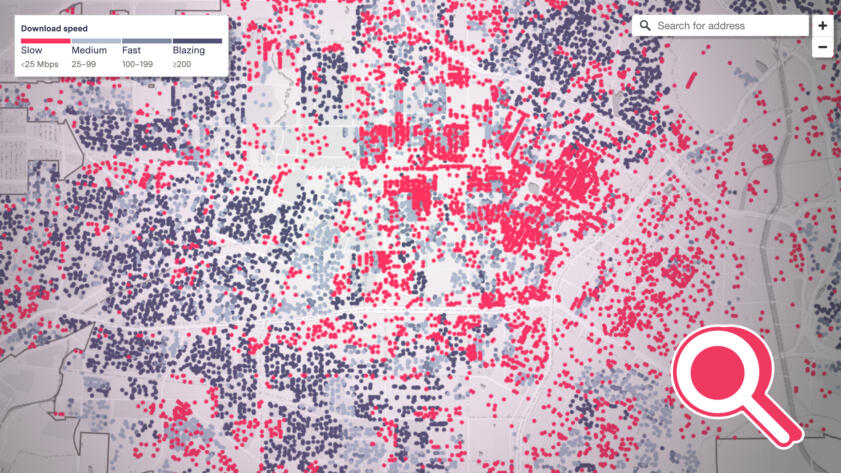
Still Loading
See the Neighborhoods Internet Providers Excluded from Fast Internet
Explore The Markup’s interactive map to see where AT&T, CenturyLink, and Verizon offered only slow internet speeds in major U.S. cities
“I had to get up late in the night or early in the morning when people were not on the internet. It required a lot of time,” Washington said. “Before I retired, I was in school, so I could work out of my office or go to the library. They’ve shut down all the libraries locally … so it was hard.”
Months ago, she purchased Skyroam, a mobile hot spot, for $130 a month. The fast speeds allowed her to complete her dissertation, and she recently received a Ph.D. from Walden University, an online university. Unfortunately, it costs “an arm and a leg” to keep the service, she said.
With affordability being a major barrier to internet access, the federal government created the Affordable Connectivity Program, which is administered by the Federal Communications Commission. It provides a discount of up to $30 per month ($75 for tribal households) toward internet service and up to $100 toward a laptop, desktop computer, or tablet for eligible households. Some people across the rural South told Capital B they’ve never heard of it. Currently, 22 million are enrolled nationwide in the program.
In the congressional district where Philadelphia is located, 37% of eligible households have signed up for the program’s benefits, according to the Institute for Local Self-Reliance’s ACP dashboard, And 49% of eligible households have signed up in the congressional district that includes Rome. Nationwide, 42% of all eligible households nationwide have signed up for the benefit.
As the program is set to run out of funds, its future depends on whether Congress will allocate more money.
Who’s accountable?
In the case of Riley, Washington, and Turner, the federal government says each location is served, despite slow speeds. Experts say this amplifies the need for more comprehensive, accurate data. It is impossible to know precisely who has high speed internet, which could leave some areas that need service the most. For example, the FCC estimates 14.5 million people lack access to broadband, whereas Broadband Now estimates 42 million. Microsoft’s estimate is 157.3 million.
The FCC defines broadband speeds of at least 25 Mbps and actual upload speeds of at least 3 Mbps, which some advocates argue is outdated. The FCC is considering a proposal to increase the minimum speed.
For years, the federal government has been responsible for developing a map on broadband access. The map tracked availability at the census block level, which a 2020 study by researchers from Princeton University found disproportionately overstated coverage in rural and minority communities. Last year, the FCC rolled out a new map using addresses, which was mandated by the Broadband Data Act.
While the agency recently made strides by updating its map, experts say it’s still not accurate, especially as allegations of falsifying data mount against internet service providers. Earlier this year, the FCC announced multiple investigations into several internet providers for potentially exaggerating where they provide high-speed internet service
Mississippi’s government has spent the past year working to improve the FCC’s broadband availability data, which serves as the basis for allocating the state’s slice of $42.5 billion in BEAD funding. To date, state officials have fixed more than 78,000 missing or incorrect addresses and over 70,000 instances where telecom companies submitted inaccurate information about the level of service they could provide.
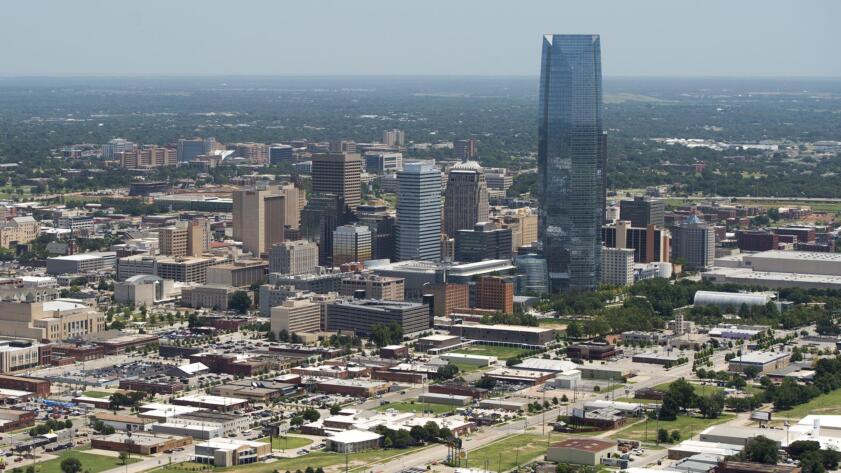
Still Loading
FCC Approves Rules to Prevent ‘Digital Discrimination’
Congress tasked the FCC with closing the digital divide. Here’s what the agency’s doing
In November, the FCC approved a set of rules aimed at ending what it calls “digital discrimination.” These rules, which the FCC was ordered to create by the 2021 Infrastructure Investment and Jobs Act, prohibit internet service providers from enacting policies that lead to disparate access to internet connectivity based on “income level, race, ethnicity, color, religion, or national origin.”
For the first time, the FCC will have the ability to issue fines against service providers engaging in discriminatory conduct. Under the agency’s rules, digital discrimination can entail anything from not deploying high-speed internet infrastructure in marginalized areas to the languages used for customer service or promotional materials.
The agency will open a tip line, where the public can submit complaints about digital discrimination that the agency can investigate. The FCC also plans on requiring internet service providers to tell the government where they are updating or rolling out new equipment, which should make it easier for regulators to determine exactly where the digital divide is being constructed.
In a letter sent to the FCC earlier this year about its digital discrimination rulemaking process, the Mississippi Center for Justice urged the agency to keep the Delta community in mind when looking to root out unfair conduct, especially when that conduct comes from government policies.
“[The Mississippi Center for Justice] expressed concerns that future broadband infrastructure grant programs may overlook the Delta, despite the region’s need for infrastructure investment,” the letter read. “Previous state-led grant programs have not produced much investment in the region. Most notably, Mississippi’s Broadband COVID-19 Grant Program resulted in broadband infrastructure projects concentrated in Northeast Mississippi, a rural, predominately White region of the state with an average median income of over $45,000.”
What can be done now?
The Congressional Research Service recommends enhancing accountability protocols or penalizing providers. The Biden administration already awarded billions to states, however, and it’s too late for residents to challenge the map. Now, it’s up to state broadband offices, in collaboration with internet providers, local governments, nonprofits, and cooperatives, to make sure everyone is served.
Sally Doty, executive director of BEAM, Mississippi’s broadband office, says it’s a huge undertaking to get all Mississippians connected to high speed internet. Before any money is awarded, the federal government has to approve their plan. She’s hosted community engagement sessions across the state, including the Delta region where Washington lives. There’s been some infrastructure build out, but she acknowledges there’s more work to do.
“We’re going to have enough money to reach everyone in Mississippi, but it is very tedious,” Doty said. “A large federal program like this has a lot of checks and balances, and we are working our way through all of those just as every state is.”
The implementation process for BEAD gives some residents hope that their states are being thoughtful about who gets the money and where it’ll go. And people like Riley will make sure their counties don’t get left behind.
“This [internet] is the greatest thing. And if we don’t cultivate that information and use it, we’re gonna get left behind by every country on this earth,” Riley said. “Sometimes it can be used for bad, but I’m just saying it’s important to have the connection to be able to access that much information.”
Additional Resources
For more information on your state’s BEAD five year action plans, equity plans, and proposals, click here.
To search broadband availability in your area, type your address in the FCC’s national broadband map. The data may be inaccurate or outdated. Read The Markup’s guide to searching for broadband deals and learn how you can help improve the FCC’s map.
Want to reach out to officials in your state’s broadband office? Or find out how much money your state received for certain programs? Find the information here.
